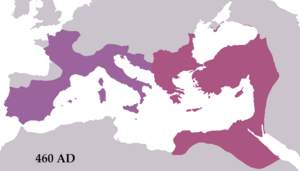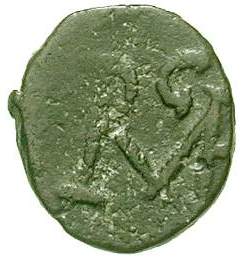Libius Severus facts for kids
Quick facts for kids Libius Severus |
|||||
|---|---|---|---|---|---|

Solidus of Libius Severus marked:
d·n· libius severus p·f· aug· |
|||||
| Roman emperor in the West (unrecognized in the East) |
|||||
| Reign | 19 November 461 – 14 November 465 | ||||
| Predecessor | Majorian | ||||
| Successor | Anthemius | ||||
| Eastern emperor | Leo I | ||||
| Born | Lucania | ||||
| Died | 14 November 465 | ||||
|
|||||
| Religion | Christianity | ||||
Libius Severus was a Western Roman emperor who ruled from November 19, 461, until his death on November 14, 465. He was born in Lucania, a region in southern Italy.
Severus was the fourth of several emperors who came to power after the main Roman ruling family, the Valentinianic dynasty, lost control in 455. He became emperor after his predecessor, Majorian, was removed from power by his top general, Ricimer. Severus was very dependent on Ricimer, and many people believe that Ricimer held most of the real power during Severus' time as emperor.
During Severus' rule, the Western Roman Empire faced many challenges. The eastern emperor, Leo I, did not officially recognize Severus as a true emperor. Also, the alliance Majorian had made with the Vandal king Gaiseric fell apart. This led to the Vandals raiding Italy.
In other parts of the empire, like Gaul and Dalmatia, officials who were loyal to Majorian refused to accept Severus' rule. Northern Italy was also invaded by the Alans. Severus is a bit of a mystery, as ancient writings don't say much about his life or personality.
Contents
Who was Libius Severus?
Libius Severus is the name scholars agree on for this emperor. Sometimes, his name was written slightly differently, like Livius, because of how Latin was spoken back then.
Some old writings also call him Serpentius. It's not clear if this was another name he used, like a nickname, or if it was a mistake in the old texts. Historians still debate this today.
What was the Roman Empire like when Severus ruled?
By the time Severus became emperor, the Roman empire was split into two main parts. There was the Eastern Roman Empire, with its capital in Constantinople (modern-day Istanbul). And there was the Western Roman Empire, with its capital usually in Mediolanum (Milan) or Ravenna.
The East was mostly peaceful, but the West faced many problems. It was invaded often, there were big political changes, and it lost important lands. By the 460s, Britain was no longer part of the empire. Africa had been taken over by the Vandals. And Hispania (Spain) was controlled by the Suebi and Visigoths.
During this time, powerful barbarian generals gained a lot of influence in both parts of the empire. Their power sometimes even matched that of the emperors. In the West, generals like Stilicho and Aëtius were very strong.
After Aëtius was killed in 454, the Western Empire started to decline quickly. The emperor Valentinian III was removed, and his family was captured. Rome itself was attacked and robbed in 455.
Out of this chaos, the general Ricimer and another general, Majorian, rose to power. Ricimer was a popular military leader. But because he wasn't Roman by birth, he couldn't become emperor himself. So, Majorian became emperor, but Ricimer still held a lot of military and political power.
Majorian was a strong emperor. He was recognized by the eastern emperor Leo I. He also made political changes and strengthened Roman control in Gaul and Hispania. However, in 461, Ricimer had Majorian killed. Historians aren't sure why Ricimer did this. Some think Majorian was too independent for Ricimer to control. After Majorian's death, Ricimer became the most powerful person in the Western Empire.
How did Severus become emperor?
After Majorian's death, there was a three-month period where no one was the Western Emperor. During this time, Ricimer, the eastern emperor Leo I, and the Vandal King Gaiseric all struggled for power.
Finally, on November 19, 461, the Roman Senate in Ravenna declared Severus to be the new emperor, or augustus.
Why was Severus' rule questioned?
Severus' rule was not fully accepted by everyone. Here are some of the main reasons:
- Vandal Pressure: After the sack of Rome in 455, the Vandal king Gaiseric had captured some women from the old Roman ruling family. He married them to his son and another nobleman. This made Gaiseric claim that his family should rule the empire. He raided the Italian coast to try and force Ricimer to replace Severus with someone from that family.
- Eastern Empire's Disapproval: The eastern emperor Leo I refused to recognize Severus as a true emperor. Eastern historians even called Severus a "usurper," meaning someone who took power illegally. This made it hard for the two parts of the empire to work together. For example, the East refused to send ships to help Italy against the Vandal raids.
- Revolts in the West: Two important military commanders, Aegidius in Gaul and Marcellinus in Illyricum, refused to accept Severus' rule. They had been loyal to Majorian. Their revolts meant that the Western Empire lost control of these important regions.
These problems continued throughout Severus' reign. Even though Ricimer eventually dealt with Aegidius and Marcellinus, the region of Dalmacia was permanently lost to the Western Empire.
What challenges did the provinces face?
When Severus became emperor, Marcellinus, a military leader in Dalmacia, was in Sicily with his army. He did not recognize Severus as emperor. Ricimer was worried about this army being so close to Italy. He managed to convince Marcellinus to leave Sicily by bribing his soldiers and getting the eastern court to talk to him.
In Gaul, Aegidius was rebelling against Severus. He couldn't cross the Alps because he was busy fighting the Visigoths. But he managed to stay independent in northern Gaul for several years. To fight Aegidius, Severus (or Ricimer) appointed Agrippinus as the new general for Gaul. Agrippinus got help from the Visigoths. In return for their help, the Visigoths received the city of Narbonne in 462. This gave them access to the Mediterranean Sea and cut off Aegidius from the rest of the empire.
Northern Italy also faced an invasion from the Alans led by King Beorgor. This invasion ended with Beorgor's defeat at the Battle of Bergamo in 464.
How did the Vandals cause problems?
After Severus became emperor, Gaiseric, the king of the Vandals, started raiding the Italian coast. He claimed he had a right to the Roman emperor's property because his son had married the emperor Valentinian's daughter. Even though he didn't openly demand that his relative become emperor, Gaiseric never gave up his claim.
These Vandal raids hurt the economy of Italy. Some important Roman landowners asked Severus to make peace with Gaiseric. Severus sent a high-ranking official named Tatian to talk to the Vandal king, but Gaiseric refused any peace terms.
What was Severus' relationship with Ricimer?
Historians have different ideas about the relationship between Ricimer and Severus. Many traditional historians believe that Severus was just a "puppet emperor" who had very little power of his own. They think Ricimer was in complete control.
However, some modern historians disagree. They argue that Severus might have had more power than old writings suggest.
One interesting piece of evidence comes from coins made around Severus' time. Some of these coins have a special symbol, or monogram, on them. Some scholars think this monogram stands for "RICIMER." If this is true, it would show how much power Ricimer had. But other scholars think the monogram might mean something else, like the city where the coin was made, or even Severus' own name.
Another piece of evidence is a bronze plaque, which was likely an official weight for coins. It reads: "Health to our Lords [Leo and Severus] / and the patrician / Ricimer." The fact that Ricimer's name is placed so close to the emperors' names shows his very important position in the state.
Ricimer was also sometimes called "king" by a historian named Marcellinus Comes. This could mean he had royal family roots, or it could show how much political power he had gained.
How did Severus die?
Severus died in Rome on November 14, 465, after ruling for almost four years. The exact details of his death are not clear, and old sources disagree. However, most modern historians believe that Severus died of natural causes.
Some ancient writings suggest that Ricimer poisoned Severus. But another writer, Sidonius Apollinaris, wrote that Severus died "according to the law of nature," which usually means a natural death. Historians interpret this differently. Some think it hints at rumors of poisoning, while others think it means there were no such rumors.
Historians who believe Ricimer might have killed Severus suggest a few reasons. Severus might have been in the way of Ricimer making peace with the eastern emperor Leo. Another idea is that Severus was more active as emperor than Ricimer wanted, and Ricimer wanted to rule alone or with an even weaker emperor. Because there isn't much evidence, it's hard to know for sure how Severus died.
Images for kids
See also
 In Spanish: Libio Severo para niños
In Spanish: Libio Severo para niños




